Gerenciar arquivos de mídia no WordPress pode parecer avassalador à medida que seu site cresce. Uma biblioteca de mídia desorganizada pode deixar seu site lento e tornar atualizações simples demoradas.
Ajudamos muitos usuários do WordPress a organizar seus sites e sabemos que alterar o local de upload de mídia vai além da simples organização.
Além de uma melhor organização de arquivos, essa mudança pode acelerar seu site, simplificar backups, aumentar a segurança e até melhorar a entrega de conteúdo.
Neste guia, mostraremos nosso método eficaz para alterar os locais de upload de mídia do WordPress. Quer você tenha um pequeno blog ou um site de negócios com muitos arquivos de mídia, você aprenderá como configurar isso da maneira certa.
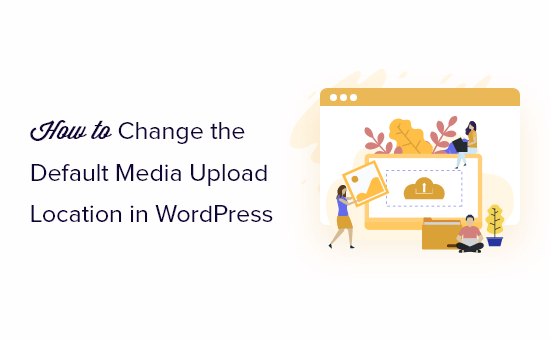
Por que Alterar o Local Padrão de Upload de Mídia?
Quando você carrega imagens, vídeos ou outros arquivos para o seu site WordPress, eles são armazenados em uma pasta específica no seu servidor.
Por padrão, o WordPress salva todos os uploads de mídia no diretório /wp-content/uploads/, que você pode encontrar no gerenciador de arquivos do seu site ou através de um cliente FTP.
Dentro desta pasta, você encontrará subpastas para os diferentes anos e meses. Por exemplo, quaisquer arquivos que você carregou em janeiro de 2024 serão armazenados em https://example.com/wp-content/uploads/2024/01/.
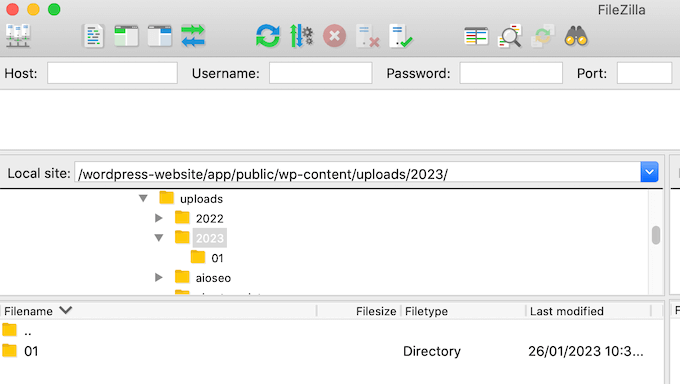
Essa estrutura padrão funciona bem para a maioria dos blogs e sites WordPress. No entanto, às vezes, você pode querer alterar onde o WordPress armazena seus arquivos.
Por exemplo, você pode hospedar imagens em um subdomínio, pois isso pode acelerar o desempenho do seu WordPress.
Se você estiver usando uma CDN, talvez queira alterar o local de upload para apontar para o armazenamento da CDN. Isso pode ajudar a distribuir seus arquivos de mídia globalmente, melhorando a velocidade de acesso para usuários em diferentes localizações geográficas.
Se você tiver necessidades organizacionais específicas, como categorizar arquivos de mídia por projeto ou tipo, alterar o local de upload permite que você crie uma estrutura de pastas que funcione melhor para o seu site.
Além disso, em um ambiente de staging, você pode querer alterar o local de upload para evitar a poluição da biblioteca de mídia principal com arquivos de teste.
Mover arquivos de mídia para uma pasta dedicada também pode acelerar o processo de backup. Se você faz backup frequente de sua mídia, tê-la em um local separado pode tornar essa tarefa mais rápida e eficiente.
Dito isso, vamos dar uma olhada em como alterar o local de upload de mídia padrão no WordPress, passo a passo. Você pode usar os links rápidos abaixo para navegar por este tutorial:
- Passo 1: Crie uma Nova Pasta de Upload no Seu Diretório do WordPress
- Passo 2: Insira o Código para Alterar o Local de Upload Padrão
- Passo 3: Altere Suas Configurações de Upload de Mídia (Opcional)
- Recursos Bônus: Gerenciando Mídia do WordPress
Passo 1: Crie uma Nova Pasta de Upload no Seu Diretório do WordPress
O primeiro passo é criar uma nova pasta para fazer o upload dos seus arquivos. Para fazer isso, você pode usar o gerenciador de arquivos do seu provedor de hospedagem ou conectar seu site a um cliente FTP como o FileZilla.
Se você nunca usou FTP antes, consulte nosso guia para iniciantes sobre como usar FTP para fazer upload de arquivos para o WordPress e como fazer upload em massa de arquivos para o WordPress usando FTP.
Para este tutorial, usaremos o gerenciador de arquivos da Bluehost, pois é muito fácil de usar. Dito isso, os passos devem ser mais ou menos os mesmos se você usar um cliente FTP ou um serviço de hospedagem WordPress diferente.
Primeiro, faça login no seu painel de hospedagem e navegue até a aba ‘Websites’. Em seguida, selecione o site para o qual deseja alterar a pasta de upload de mídia e clique em ‘Configurações’.
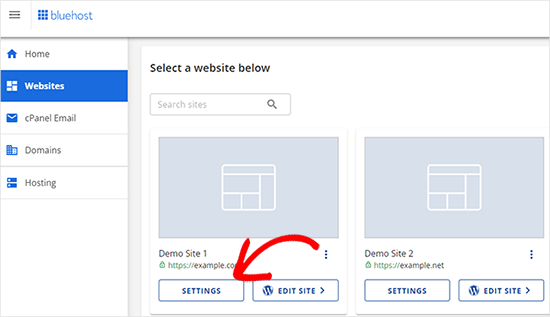
Na próxima tela, role para baixo até a seção ‘Links Rápidos’.
Em seguida, clique em ‘Gerenciador de Arquivos’. Bluehost também mostra a pasta raiz do seu WordPress caso você precise dela mais tarde.
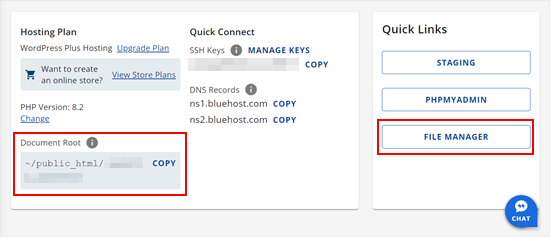
Agora você deve estar dentro do gerenciador de arquivos do seu próprio site.
Agora, abra sua pasta wp-content. Em seguida, clique em ‘+ Pasta’ no topo.
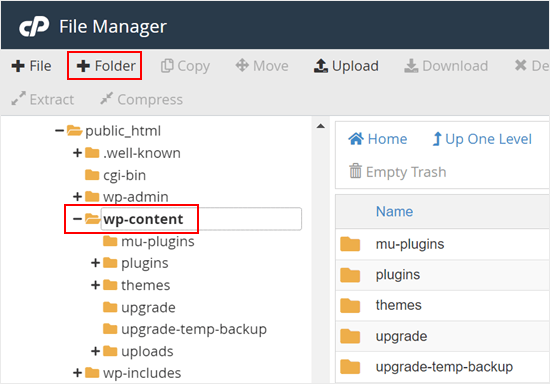
Em seguida, dê um nome à sua nova pasta. Pode ser algo simples como ‘arquivos’. Anote o nome exato da pasta, pois você precisará dele na próxima etapa.
Depois disso, basta clicar no botão ‘Criar Nova Pasta’.
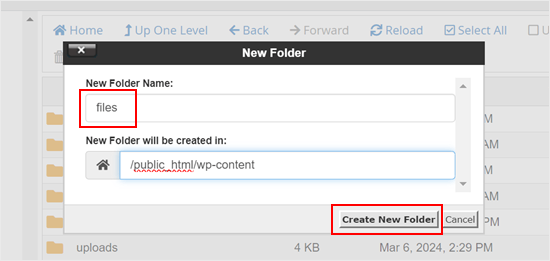
Passo 2: Insira o Código para Alterar o Local de Upload Padrão
Em seguida, você precisará adicionar um trecho de código que diga ao WordPress para alterar o diretório de mídia padrão.
💡 Dica Profissional: Antes de continuar com esta etapa, recomendamos criar um backup do seu site. Isso garante que seus dados estejam seguros caso ocorra algum erro.
Para este tutorial, você precisará adicionar o trecho de código personalizado ao arquivo functions.php do seu tema.
O maior problema é que até mesmo um pequeno erro no trecho de código personalizado pode quebrar seu site WordPress ou até mesmo torná-lo inacessível. Além disso, você perderá todo o código personalizado na próxima vez que atualizar seu tema WordPress.
Por esse motivo, recomendamos o uso do WPCode. O WPCode é o plugin de snippets de código mais popular que permite adicionar CSS, PHP, HTML personalizados e muito mais sem colocar seu site WordPress em risco.
Saiba mais sobre o que o plugin pode fazer nesta análise detalhada do WPCode.
A primeira coisa que você precisa fazer é instalar e ativar o plugin gratuito WPCode em seu site. Para mais detalhes, consulte nosso guia passo a passo sobre como instalar um plugin do WordPress.
Após a ativação, vá para Snippets de Código » Adicionar Snippet no seu painel do WordPress.
Nesta tela, passe o mouse sobre ‘Adicionar Seu Código Personalizado (Novo Snippet)’ e clique em ‘Usar snippet’ quando ele aparecer.
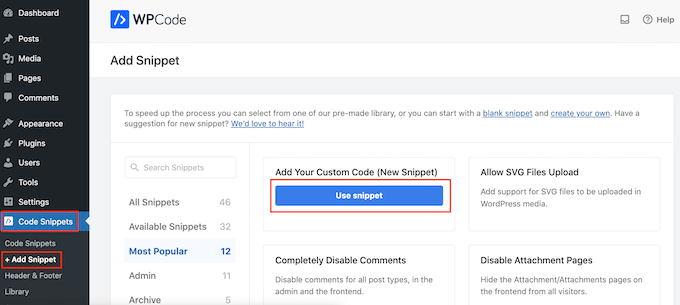
Para começar, digite um título para o trecho de código. Isso é apenas para sua referência, então você pode usar o que quiser.
Com isso feito, abra o menu suspenso ‘Tipo de Código’ e escolha ‘Snippet PHP’ como seu tipo de código.
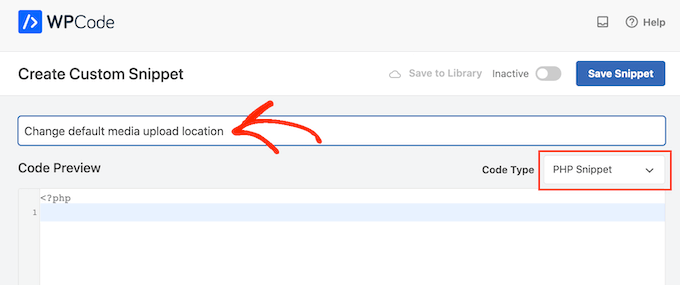
Agora você pode colar o seguinte no editor de código:
define( 'UPLOADS', 'wp-content/'.'files' );
O snippet acima altera o diretório de upload para wp-content/files, como em nosso exemplo anterior. Certifique-se de substituí-lo pela localização que deseja usar.
Depois disso, role até a caixa ‘Inserção’ e selecione ‘Inserir Automaticamente’ se ainda não estiver selecionado. Você pode então abrir o menu suspenso ‘Localização’ e escolher ‘Executar em Todos os Lugares’ para garantir que o snippet esteja ativo em todo o seu site WordPress.
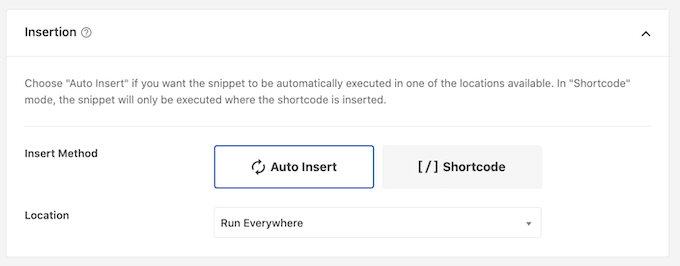
Com isso feito, role até o topo da tela e clique no alternador ‘Inativo’ para que ele mostre ‘Ativo’.
Em seguida, você pode clicar em ‘Salvar Snippet’ para tornar o código ativo.
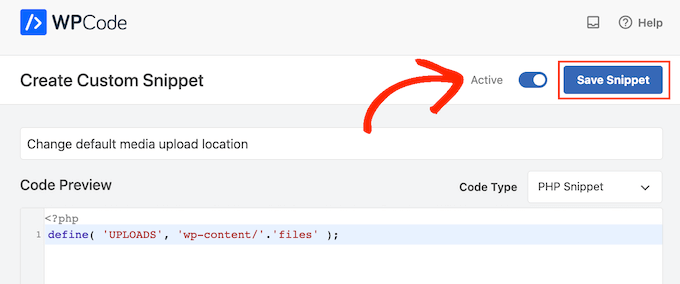
Passo 3: Altere Suas Configurações de Upload de Mídia (Opcional)
Agora que você alterou o local de upload de mídia, talvez queira mudar como os arquivos são organizados dentro desta nova pasta.
Por padrão, o WordPress armazena todos os arquivos de mídia dentro de pastas de mês e ano. Se você preferir salvar todos os arquivos na mesma pasta, vá para Configurações » Mídia.
Agora você pode desmarcar a caixa 'Organizar meus uploads...' e clicar em 'Salvar alterações'.
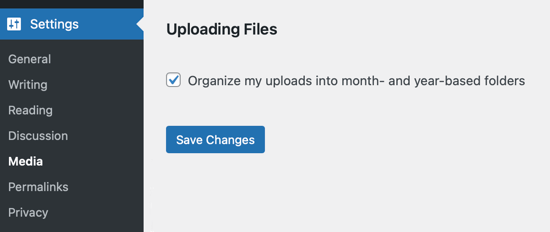
Agora, o WordPress fará o upload de todos os seus arquivos de mídia para a mesma pasta. Para ver esses arquivos, basta conectar-se ao seu site usando um cliente FTP e, em seguida, abrir a pasta que você selecionou.
Recursos Bônus: Gerenciando Mídia do WordPress
Procurando mais maneiras de otimizar ou melhorar a forma como você gerencia a mídia no WordPress? Confira estes guias úteis:
- Como Organizar Facilmente Uploads de Mídia por Usuários no WordPress
- Como Renomear Imagens e Arquivos de Mídia no WordPress
- Como Limpar sua Biblioteca de Mídia do WordPress (Maneiras Fáceis)
- Como Descarregar Mídia do WordPress para Melhorar a Velocidade do Site
- Como Baixar Toda a Sua Biblioteca de Mídia do WordPress
- Como fazer upload em massa de arquivos de mídia do WordPress usando FTP
Se você gostou deste artigo, por favor, inscreva-se em nosso Canal do YouTube para tutoriais em vídeo do WordPress. Você também pode nos encontrar no Twitter e no Facebook.





Manu
É necessário ou melhor fazer o upload de arquivos de mídia no local de upload de mídia? Por exemplo, o local padrão de upload de mídia é wp-content/uploads/, mas eu quero colocar arquivos de áudio em /files1/ e /files2 etc. Isso é um problema?
Estes arquivos de áudio ainda serão reproduzidos perfeitamente, embora não apareçam na biblioteca (mas eu não preciso disso). Eu só preciso de um URL curto para códigos QR em audiolivros. Obrigado.
WPBeginner Support
Depende da preferência pessoal de onde você define seus arquivos de mídia, não há um local especificamente melhor e tudo bem mudar a localização da mídia.
Admin
Arif Wali
Olá,
Eu consegui fazer isso com sucesso. Quando eu faço upload de arquivos, o sistema mostra o erro “O arquivo enviado não pôde ser movido para arquivos”. Você poderia me ajudar com isso?
WPBeginner Support
O motivo mais provável seria se as permissões do seu arquivo não estiverem configuradas corretamente para a pasta. Você gostaria de dar uma olhada em nosso artigo abaixo para mais informações sobre como configurar as permissões da sua pasta:
https://www.wpbeginner.com/beginners-guide/how-to-fix-file-and-folder-permissions-error-in-wordpress/
Admin
arif wali
Muito obrigado
S.s. Brar
Primeiramente, obrigado a vocês. Tenho uma dúvida. Quando eu mudo o diretório de upload padrão, o que acontece com a mídia/arquivos já enviados para o diretório de Uploads padrão.
Para ser mais claro, isso quebrará algo no meu site que já está funcionando?
WPBeginner Support
A menos que você mova a mídia antiga para a nova pasta, sua mídia antiga mostrará links quebrados
Admin
a
Olá
Posso remover o plugin depois disso?
WPBeginner Support
Olá,
Qual plugin você quer remover?
Admin
dele
por favor, estou tendo este erro abaixo que não me permitiu carregar imagens na minha página ou post
UPLOADING
Ignorar Erros
12742841_1155189411165548_8438395707068412258_n.jpg
Ocorreu um erro no upload. Por favor, tente novamente mais tarde.
WPBeginner Support
Você pode consultar nosso guia sobre como corrigir o problema de upload de imagens no WordPress.
Admin
muhammed
quero mudar a pasta de upload padrão para outra hospedagem.
encontrei alguns plugins, mas eles não mudam a "pasta padrão!".
meu site está rodando com um plugin automático que envia fotos automaticamente para a pasta padrão. posso mudar a pasta padrão no meu webhost, mas não para outro servidor!
O que devo fazer? por favor, me ajude
dan
você é incrível.
Ben
Este método também funciona ao alterar a pasta de upload para um local externo?
Fauzi
thanks for sharing,,,
very helpfully
Rio Bermano
Olá, obrigado por este tutorial.
Mas tenho uma pergunta.
ele voltará ao padrão (wp-content/upload) novamente quando o WordPress for atualizado?
Cheers
Héctor Cabrera
Ei pessoal! Vocês deveriam mencionar no artigo que o código “define” deve ser colocado em algum lugar _antes_ da linha “That’s all, stop editing! Happy blogging.”. Caso contrário, causará problemas para alguns usuários (veja mais detalhes).
Joe
Obrigado! Você realmente me salvou umas 10 horas de trabalho!
H. T. Major
As dicas que você fornece são muito úteis… como esta! Por favor, como você “volta” dois diretórios? Por exemplo, se eu tenho http://example.com/wp/wp-content/files mas quero http://example.com/files, ( ‘UPLOADS’, ”.’files’ ) não funciona para me levar até lá. Isso me leva a http://example.com/wp/files.
Muito obrigado por qualquer direção que alguém aqui possa fornecer!
Miles
H.T. Major e qualquer outra pessoa que tenha algo como a seguinte estrutura para o WordPress:
RAIZ WEB
– wp-content
— uploads
– arquivos_instalacao_wordpress
usar define(‘UPLOADS’,’wp-content/uploads/’); não funcionará porque está usando a raiz do WordPress como local relativo. Na verdade, não parece aceitar nenhum tipo de caminho absoluto, etc., apenas o anexa à raiz do WordPress.
Mas se você usar:
define(‘UPLOADS’,’..wp-content/uploads/’); isso deve funcionar da maneira que você está procurando. Eu lutei com isso por um tempo e isso parece resolver o problema.
Miles
Editar, para ser mais limpo, remova a barra final: define(‘UPLOADS’,’..wp-content/uploads’);
Isso voltará dois níveis, saindo da sua pasta do WordPress, presumivelmente para a raiz do site e depois para a pasta wp-content/uploads.
Peter
E se eu quiser mudar o upload assim?
Antigo: /home/public_html/wp-content/uploads
novo: /home/nova pasta/uploads
Nico
Como alterar a pasta da biblioteca de mídia na versão 4.0?
Equipe WPBeginner
Por favor, dê uma olhada neste guia:
Como criar facilmente um slider responsivo do WordPress com Soliloquy
Equipe WPBeginner
Sim, é possível. A melhor maneira é usar um Serviço de CDN. Isso oferece melhor redundância e torna seu site mais rápido.
No entanto, se você apenas deseja alterar o diretório de upload de mídia e a velocidade não é sua preocupação, você deve procurar por wp-ftp-media-library.
Sandeep
Obrigado. Pesquisei sobre CDN, mas descobri que ele apenas armazena em cache as imagens para servi-las de um local remoto que está mais próximo do usuário. Eu só quero fazer upload para um servidor diferente, portanto, a segunda opção pode funcionar para mim.
Mas como sinto que FTP pode não ser realmente seguro, você tem alguma solução de como posso usar outro protocolo como HTTP/HTTPS ou Rsync para fazer o mesmo (fico imaginando se o WP suporta isso).
Sandeep
É possível definir o local de upload para outro servidor remoto?
Somesh
Quero usar um subdomínio diferente, como mover e alterar o caminho para o endereço desse subdomínio
HasaN
Eu mudei meu caminho de upload
mas minhas antigas imagens em destaque e links de mídia agora mudaram para o novo caminho e estão quebrados!
Eu quero que apenas os links e o caminho da nova mídia que foi carregada sejam alterados para o novo caminho
ali es
Olá. Como mudar o endereço de upload de mídia para o servidor. Eu não falo inglês e traduzi o texto com o Google Tradutor. Por favor, me guie.
Obrigado
Jovin
Se eu mudar o diretório de uploads, devo mudar todos os meus uploads anteriores para o novo diretório?
WPBeginner Support
Primeiro, certifique-se de fazer backup do seu diretório de uploads existente antes de alterar o local padrão de upload de mídia no WordPress. Você pode deixar seu antigo diretório de uploads como está para que mídias mais antigas em seu site não quebrem. No entanto, se você não quiser usar o antigo diretório de uploads de mídia, saiba que os locais de mídia em suas postagens, páginas e widgets são URLs codificados, portanto, eles não mudarão sozinhos. Você pode tentar importar imagens externas e verificar seu site em busca de links quebrados para garantir que todas as imagens em seu site estejam aparecendo corretamente.
Admin
Jovin
Thanks for the reply
Arvind Bhardwaj
Obrigado,
Funcionou perfeitamente no WP 3.5.1
Travis
Peço desculpas pelo comentário, um pouco atrasado. Este é o único artigo que consegui encontrar que aborda isso para as instalações mais recentes do wp (3.6.1). Todos os outros são sobre a pasta misc. De qualquer forma, segui os passos e funcionou, mas as imagens estão quebradas. Estou trabalhando apenas com algumas imagens, então não é um grande problema reenvia-las.
Então, presumo que preciso criar uma nova pasta “media” (meu caminho). Isso seria em uploads ou para substituir uploads? O URL que estou procurando é http://mydomain/media/image.png. Não consigo descobrir.
Qualquer ajuda para qualquer um é muito apreciada
WPBeginner Support
você precisa definir o caminho de upload no arquivo wp-config.php assim:
define( 'UPLOADS', ''.'media' );Admin
K.Adam White
Como muitos outros comentaristas, eu queria uma maneira de armazenar meus uploads de mídia no mesmo diretório da minha instalação do WordPress, por exemplo, para ter o WordPress em “mydomain.com/wp/” e minha mídia em “mydomain.com/uploads/”. Consegui fazer isso funcionar para mim no WordPress 3.5 adicionando o seguinte ao functions.php do meu tema (ou a um plugin):
if ( empty( $upload_path ) || ‘wp-content/uploads’ == $upload_path ) { update_option( ‘upload_path’, untrailingslashit( str_replace( ‘backend’, ‘files’, ABSPATH ) ) ); update_option( ‘upload_url_path’, home_url( ‘/files’ ) ); }
Esperamos que isso fique mais fácil em uma futura versão do WordPress!
K.Adam White
Atualização: No exemplo acima, substitua “backend” por “wp” (ou onde quer que seu WordPress esteja instalado)
David Paul
Embora isso pareça resolver o problema apenas olhando, por que você não adicionaria apenas 1 linha ao seu arquivo wp-config em vez disso? Parece muito trabalho extra para o mesmo resultado que este post apresenta…
Adicionar define(‘UPLOADS’,’directory’); é muito mais fácil.
Yury Tilis
Porque em wp-includes/functions.php, você tem os seguintes 2 cenários:
Se nenhum diretório de upload específico for especificado:
$dir = WP_CONTENT_DIR . ‘/uploads’
Se UPLOADS estiver definido:
$dir = ABSPATH . UPLOADS;
O problema aqui, que deveria ser óbvio, é que ABSPATH != WP_CONTENT_DIR o tempo todo. Se você tem o WordPress instalado em um diretório e aponta para ele com WP_SITEURL, mas especifica um diretório diferente para wp-content com WP_CONTENT_DIR, de repente UPLOADS não faz sentido, e uma simples renomeação de pasta se torna impossível sem o hack acima ou um similar.
Derek Lapp explica bem aqui:
nate
Talvez eu esteja completamente fazendo isso da maneira errada, mas estou usando uma instalação multisite para desenvolver os sites dos meus clientes… Como uso o editor de código no backend do WP, gosto de usar o uploader de imagens também para fazer upload de imagens para o CSS carregado…
Que eu criei um tema inicial incrível que uso o conteúdo do widget da barra lateral e imagens carregadas para certas áreas como local de logotipo e até mesmo para imagens de fundo – uma maneira “preguiçosa” de enviar imagens para o servidor..
Eu queria usar caminhos relativos no meu CSS caso eu mova o site/tema ou mude os nomes de domínio e não queria usar o caminho normal wp-content/blog23/files que é o caminho padrão do uploader de imagens…
Para 1 isso fica fora do meu tema e eu gostaria de simplesmente usar background: url (‘images/filename.png’) no meu CSS com imagens que eu carrego via uploader de imagens do WP para que quando meu tema se mover meus links/imagens não quebrem e então eu planejo “depois que o site estiver pronto para ir ao ar” mudar o caminho de upload de volta para wp-content/blog23/files
Só pensando que isso tornaria minha vida mais fácil e claro que provavelmente estou ignorando algo ou sendo preguiçoso, mas eu prometo que não estou – sou novo nisso… : )
Mudei o caminho de upload nas configurações do site, mas nada mudou? ainda faz o upload para o caminho de arquivos dos blogs?
Nico
Não consigo fazer isso (copiado de outro lugar neste tópico) funcionar:
define(‘UPLOADS’, ‘files’);
Está no meu wp-config.php.
Eu quero minhas imagens em exemplo.com/img
Qualquer ajuda é bem-vinda.
Por que eles sequer se dão ao trabalho de mudar coisas assim. Era um recurso TÃO útil.
Nico
Resolvi o problema. Quando copiei o código desta página, as aspas eram do tipo "elegante". Quando as tornei simples, o código funcionou.
Obrigado por isso.
Nico
Este é o tipo de mudança que os desenvolvedores de software fazem quando perdem o contato com seus usuários.
A explicação que li para remover essa opção é que poucas pessoas a usavam e isso deixa a interface mais limpa. Que bobagem.
Josef
Eu quero o caminho dos meus arquivos para ser exemplo.com/files
Apenas para deixar o back-end mais polido e esconder o fato de que uso WordPress.
Minha pergunta é, terei algum problema se eu aplicar este método no futuro? Próximas atualizações do WordPress ou migração do site para outro host... etc?
É perigoso?
Equipe Editorial
Sempre que você decide fazer as coisas de forma diferente do que é feito no núcleo, você assume a responsabilidade e os riscos de compatibilidade futura.
Admin
Josef
Eu entendo 100%.
Mas eu quero uma resposta para a minha pergunta, serei grato.
Equipe Editorial
Sua pergunta foi se você enfrentaria algum problema, e nossa resposta foi respondendo a isso. Não sabemos porque muitas coisas podem mudar, mas se você enfrentar algum problema, a responsabilidade é sua.
Dan A.
@Josef
As atualizações nunca afetaram meus sites que usam este método. Se você mudar de host, apenas certifique-se de que o diretório especificado no seu arquivo de configuração permaneça consistente com o diretório que contém os arquivos reais e você não terá problemas.
Mudei de hospedagem uma vez e decidi renomear meu diretório de upload… Depois de mover as imagens para o novo diretório, tive links quebrados para todas as imagens e arquivos com o nome do diretório antigo. Foi um incômodo ter que ir ao banco de dados e atualizar os caminhos dos links quebrados.
Apenas seja consistente.
James
Olá,
Pergunta, como posso personalizar o diretório de upload por usuário?
Existe algum plugin disponível para esse requisito?
Obrigado!
Papa Smurf
Pro tip: you don’t need to prepend empty strings to strings.
define(‘UPLOADS’, ”.’files’);
deveria ser:
define(‘UPLOADS’, ‘files’);
O código fonte do Wordpress já é bagunçado o suficiente como está…
Facu
Muito obrigado! Isso foi muito útil para mim
Connie
Notei que após a atualização para 3.5.1 o uploader de mídia não funcionou nada. (Ainda não funciona)
além disso, alguns plugins parecem usar o convencional “wp-content/uploads” em vez de constantes ou configurações…
isso é realmente um problema, não consigo usar o uploader de mídia…
Connie
Adicionei a constante ao wp-config. o upload de mídia está enviando para a pasta definida, mas a entrada de mídia ao editar uma postagem, não está funcionando nada, vazia, sem reação ao clicar…
que audácia…
Matteo
talvez seu servidor seja windows, melhor um linux
Equipe Editorial
Você sempre terá problemas com plugins quando fizer isso. Esta opção não é para ser usada por usuários médios. Ao usá-la, você precisa ter um motivo bom o suficiente para fazê-lo.
Admin
Mattia Frigeri
Sou o único que acha que talvez a pasta “upload” esteja bem, mas a melhor organização não deveria ser nem por anos ou meses, mas pelo slug da postagem/página em que o arquivo está contido? Não o título, mas o slug! Isso talvez pudesse criar problemas com uma única imagem usada em 2 postagens/páginas, embora. Mas eu nunca uso uma imagem em 2 lugares diferentes?
RVOLA
Olá, escrevi um pequeno plugin para as novas funcionalidades do WordPress 3.5.
Você pode modificar diretamente o domínio ou subdomínio
http://wordpress.org/extend/plugins/wp-original-media-path/
FragaGeddon
Obrigado, isso funciona bem!
Chaitanya
Por favor, ajude...
Eu estou bem com a pasta de upload padrão, mas não consigo fazer upload de nenhum arquivo nessa pasta sem definir sua permissão para 777. Mas eu sinto que isso pode ser perigoso. Existe alguma alternativa?
Equipe Editorial
Fale com o administrador do seu servidor.
Admin
fred
lol legal, você soa como o suporte técnico da MS dizendo ao administrador para falar com o administrador dele como resposta para o problema
Equipe Editorial
O usuário tem medo de mudar as permissões para 777. Nós não temos controle sobre os servidores deles e não sabemos se o usuário também tem. Então não temos certeza de como exatamente você gostaria que ajudássemos.
Samarn
De outra forma, você pode usar esta URL /wp-admin/options.php para alterar o caminho do diretório de uploads. Em seguida, procure por upload_path para inserir o caminho do seu diretório de uploads. Por padrão é wp-content/uploads. Você pode mudar para wp-content/files para o diretório de arquivos em wp-content. Ou você pode mudar para files para o diretório de arquivos no mesmo nível do wp-content.
Se você quiser armazenar mídia em um subdomínio. Você deve inserir a URL do seu subdomínio em upload_url_path e, em seguida, apontar seu subdomínio para o caminho do diretório de upload acima.
Depois de mudar isso. Você deve renomear o nome do diretório antigo para o novo nome do diretório ou mover todos os arquivos e diretórios do diretório antigo para o novo diretório. Se você não fizer isso. Arquivos não encontrados.
espero que isso seja útil e desculpe pelo meu inglês.
Chris
Obrigado, isso foi muito, muito útil.
Dave
Você *PODERIA* fazer isso, vai funcionar, mas você está alterando um arquivo principal. Isso tem um grande potencial de quebrar quando atualizar o WP. É melhor alterar o arquivo wp-config como sugerido aqui, pois ele NÃO é tocado durante uma atualização.
A.K.
Mudança estúpida! Eu até mudei a pasta para algo como /images/...
John
Eu pensei que estava chegando a algo aqui. Tenho uma configuração do WP com 12 sites. É novíssimo. Um dos sites está perfeito, mas nos outros não conseguimos fazer com que as imagens/documentos enviados apareçam. Eles estão sendo referenciados em uma pasta que não existe. Em vez de digitar tudo isso aqui, você pode ler a discussão no WordPress em http://wordpress.org/support/topic/pictures-do-not-display-3?replies=5. A discussão esfriou, mas preciso desesperadamente de ajuda e qualquer ajuda seria apreciada.
Henry
O mesmo que acima, tentei instalar a versão 3.5 em alguns sites novos e, o que quer que eu faça, não consigo mudar para um subdomínio. Novamente, alguém sabe como mudar o upload de mídia para um subdomínio?
Ed
obrigado por postar. Acho que estou perdendo alguma coisa, pois quero usar seu exemplo para adicionar imagens a um diretório raiz, exemplo: “http://meudominio/images”
E com base no seu exemplo, o que estou fazendo é inserindo como isto:
define ( ‘UPLOADS’, ‘http://mydomain/images’ ‘.’files’ );
O problema é que minha mídia agora mostra o endereço como “http://outradominio/http://meudominio/images”, então, basicamente, a mídia ainda está permanecendo no domínio atual e não está sendo movida para fora do domínio para um diretório raiz.
Espero que tenha feito sentido. Algum conselho?
Jaybe
O que você fez não é consistente com o exemplo fornecido. O exemplo fornecido define apenas a localização/caminho do diretório, não a URI.
Você está incluindo o esquema (http://) que não é apropriado e, além disso, quebra as coisas ao configurar o diretório/localização de uploads.
Você, presumivelmente, também deseja definir a URI para uploads.
Outros nos comentários parecem estar perguntando a mesma coisa.
— por exemplo, Como faço para fazer upload e servir uploads/mídia de um subdomínio?
Observe que há duas especificações de localização para uploads/mídia:
1. Diretório/localização de uploads.
2. URI.
O diretório/localização de uploads pode ser especificado como uma constante da seguinte forma:
define( ‘UPLOADS’, ”.’files’ );
Isso permitiria o upload e a referência de arquivos, através do domínio padrão, da seguinte forma:
(exemplo) http://domain.tld/files
Isso apenas define o caminho/localização do diretório, NÃO o sub/domínio.
2. URI
A URI é o URL/caminho completo para acessar os uploads, precedido pela constante UPLOADS (#1 acima).
Isso, infelizmente, e estranhamente, não está disponível para ser definido como uma constante. No entanto, pode ser definido via filtro (wp_upload_dir) ou editando diretamente a entrada da tabela do banco de dados.
A localização da entrada da tabela do banco de dados é a seguinte:
Banco de Dados/ wp_options/ upload_url_path
* Observe que, ao editar upload_path e/ou upload_path_url no banco de dados, você reativará a interface do usuário para gerenciar esses campos daqui para frente, como antes, através da seção WordPress Admin/ Mídia/ Uploading Files.
Para aqueles que desejam hospedar mídia via sub/outro-domínio, você pode modificar o upload_url_path de forma semelhante a como segue:
database/ wp_options/ upload_url_path:
(exemplo) http://mycdn.mydomain.tld
Claro, você precisará configurar seus servidores web para apontar corretamente o subdomínio/domínio para o local/diretório correspondente a partir do qual servir.
Espero que isso ajude.
Julie Olson-Rachlin
Jaybe — OBRIGADO. MUITO.
Eu nunca tive nenhum problema com isso – até hoje.
Paz!
Hamza
e se eu quiser colocar a mídia em um subdomínio?
evan
Tenho a mesma pergunta
Eddy
Obrigado. Seu tutorial é muito útil..
chrismccoy
ótimo post, o define não é muito documentado, então é ótimo que alguém esteja postando sobre isso, tive alguns clientes que tinham seus uploads em /pics e /images, então isso não era possível via 3.5 sem o define para novas instalações.
Rhea
Olá. Obrigado por isso. Mas preciso que as imagens sejam salvas fora do meu site WordPress..
por ex.:
public_html/site /// este é o meu site wordpress
public_html/media /// é aqui que quero salvar todas as imagens em vez disso.
TIA
Pietro Gregorini
Gostaria de saber a mesma coisa, se é possível colocar a pasta de uploads FORA da raiz do WordPress.
Sam Ward
Você precisa alterar o upload_url_path que foi mencionado anteriormente, mas isso envolve alterar um dos arquivos principais do WordPress.
Há um bom plugin postado alguns posts acima que fará tudo para você.
You can uninstall the plugin once you have made your changes to.
Saurabh
e se eu quiser colocar a mídia em um subdomínio?
Carlos Varela
Você pode definir no seu wp-config um host de mídia
define (‘MEDIA_HOST’, ‘http://media.yourdomain.com’);
Maarten
Não estou muito feliz com essa mudança porque meu WordPress usa um subdomínio para servir a mídia enviada. Isso ainda funciona após a atualização, mas não está mais disponível em novos blogs..
Sem os dois campos para definir o diretório de upload e o caminho para download, só consigo servi-los do mesmo domínio que o WP, e não de um domínio sem cookies como eu quero.
Jaybe
Ainda é possível definir tanto o caminho quanto o URI através de suas respectivas entradas no banco de dados.
Não é tão elegante quanto usar uma constante definida, mas é igualmente fácil e acessível para a maioria que está considerando mexer com tais configurações.
Sheik Yerbouti
Meu site é completamente https. Todos os plugins de slideshow que tentei inserem o URL fornecido para a imagem para exibi-la. O problema é que qualquer página que usa um slideshow é relatada como tendo conteúdo não seguro. Parece não haver como editar o URL no(s) slideshow(s) ou nas páginas de Mídia. Como edito um URL para tornar os slideshows seguros?
Sheik Yerbouti
Tente o WP Original Media Path. Este plugin mudará o caminho e todos os caminhos de arquivo existentes de uma só vez.